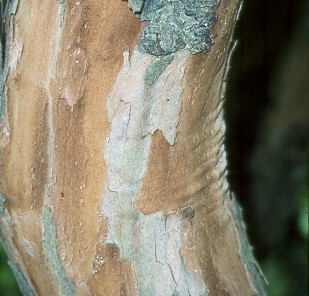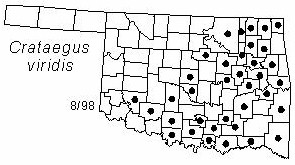
Small tree to 11 m (35 ft) tall and 15 cm (6 in) in diameter. Crown dense, rounded. Bark pale gray, scaly, with orange inner bark. Twigs brown, glabrous, spines mostly absent. Leaves alternate, simple, ovate-oblong, 2.5-6.3 cm (1-2.5 in) long, 1.2-3.8 cm (0.5-1.5 in) wide, glabrous when mature; cuneate or rounded at base, acute to acuminate at apex; margins serrate or doubly serrate, often with shallow lobes toward the base, tufts of hairs present where veins join, dark green above, paler beneath; petioles slender and glabrous. Flowers in corymbs, glabrous, 8-20 flowers borne on long slender pedicels, 1.5 cm (0.6 in) wide; calyx 5-lobed; petals 5, white; styles 5; stamens 20, pale yellow; flowers appear from March to April. Fruits pomes, small, 6 mm (0.25 in), globose, red or orange; 3-5 nutlets, dorsally grooved, matures in autumn.
Distribution: Virginia west to southern Indiana, Kansas, Oklahoma, Texas, east to Florida. Common throughout much of Oklahoma.
Habitat: moist soils in lowland and valleys. Grows in thickets.
Comments: Crataegus is from the Greek meaning "flowering thorn"; viridis means green.
Field identification: Easily recognized by the sparse number or absence of spines.
Horticulture: Green hawthorn is suitable as an ornamental.
Wildlife benefits: In general, the fruits of hawthorn species are eaten by several species of birds. The dense branching patterns supply shelter.
NWI status: FAC, FACW.
Distribution in Oklahoma: 
BACK
NEXT
RETURN TO INDEX
Last update: 9/9/99
 Go to Oklahoma Biological Survey Home Page
Go to Oklahoma Biological Survey Home Page
 Disclaimer
Disclaimer